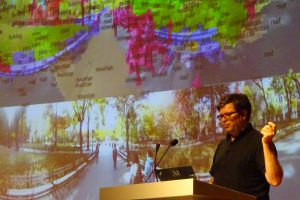Facebook’s head of AI: open innovation accelerates scientific progress

Yann LeCun delivers Holst Memorial Lecture, says open innovation is route to faster scientific progress
Yann LeCun, head of Facebook’s Artificial Intelligence Research Group (FAIR), and considered one of the doyens of AI, delivered this year’s Holst Lecture, as the recipient of the 2018 Holst Medal. The annual award is hosted by Philips, Signify and TU/e, and is in honour of the significant contribution to research made by Dr Gilles Holst, director of Philips’ NatLab from 1914 to 1946.
Erika van der Merwe and Jean-Paul Linnartz covered the event for Radio 4 Brainport
On InnovationOrigins.com, Erika wrote about this event, the following, but you can listen to our podcast on
https://www.patreon.com/posts/23034773
LeCun, who in 2013 was asked by Mark Zuckerberg to drive Facebook’s AI research programme, is a strong proponent of open innovation and multi-disciplinary research, much in the spirit of the approach taken by Dr Holst. He is known for his work in machine learning, computer vision, mobile robotics, and computational neuroscience., and developed handwriting recognition technology used by many banks worldwide, and for his image compression technology, DjVu, used extensively to access scanned documents online. His convolutional neural network model is used in image recognition by companies such as Facebook, Google, Microsoft and Baidu.
Having flown in overnight from his New York base, and dressed in the casual elegance more reminiscent of his Silicon-valley employer than of his engineering and academic profession, LeCun addressed students, academics and industry-based researchers in the TU/e Auditorium in Eindhoven. Along with an overview of the history of AI, he outlined some of the research questions that FAIR is addressing today, as well as some of the features that AI simply cannot provide yet, given the current state of science. What we are still missing are machines with common sense, intelligent personal assistants, smart chatbots and household robots.
The reason why this is not yet possible, he says, is that machines do not yet have the ability to reason, nor can they react by planning suitable action. “For that, machines need a model of the world”.
The FAIR team, which has around 200 members worldwide, publishes all of its work, in the form of papers and source code, in the public domain. LeCun says this is in the interest of speeding up scientific innovation in AI. “The reason why we do this, is that we get people to use our tools, and we get people to improve on our method, so that it becomes much easier for us to move faster, essentially. We need to make progress faster”.
Wijnand IJsselstijn, a professor at the TU/e and chair of the 2018 Holst Memorial Committee, described the selection process to Radio4Bainport: “The award is a great honour bestowed upon scientists who do relevant work in the areas of technology, that are relevant to Philips, Signify and TU/e. We make a shortlist of scientists based on the relevance of the research generated and on the impact on people, in the environment that is relevant to the topic. This year the topic was AI and data science”.
IJsselstijn says some of the distinguishing aspects of LeCun’s work include his multi-disciplinarity. “This to me is a big appeal of his work. Also there is great practical significance to his work: Much of what he does is immediately applied to machine learning and image recognition, and to compression algorithms. He has an amazing track record in this area. All of that together makes him a very good candidate for the Holst Medal.”
LeCun, who maintains strong ties with academia through his professorship at New York University, has several ambitions for scientific developments in AI, including discovering whether self-supervised learning – which he believes will be the future of AI – can lead to common sense. As he put it, “a robot has less common sense than a house cat”.
One of his ambitions for the scientific future of AI is to develop a theory that could explain the underlying mechanisms of intelligence, whether human or machine intelligence. Describing this as equivalent to developing the theory of thermodynamics after the steam engine was built, he says that, “in the history of science and technology, it is very much the case that the artefact was created before the science was created to explain how it works. In fact, the science was motivated by the fact that the artefact already existed. Now, what is the equivalence of thermodynamics for intelligence? That is the question that I am after”.